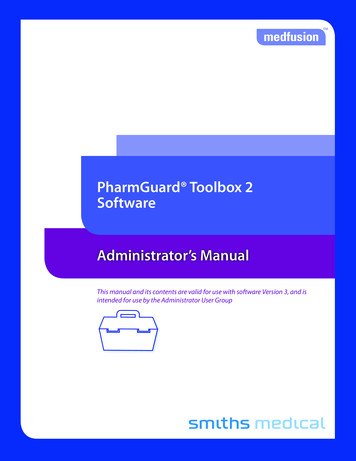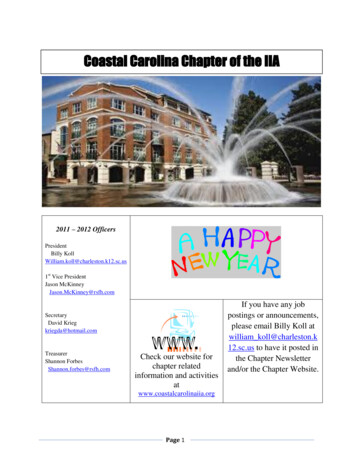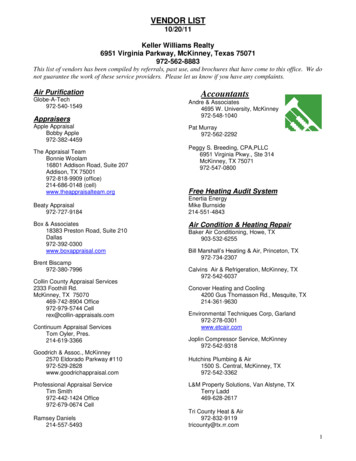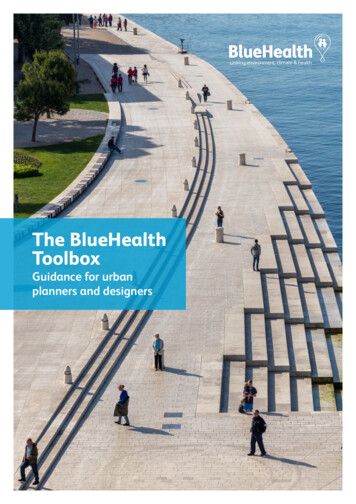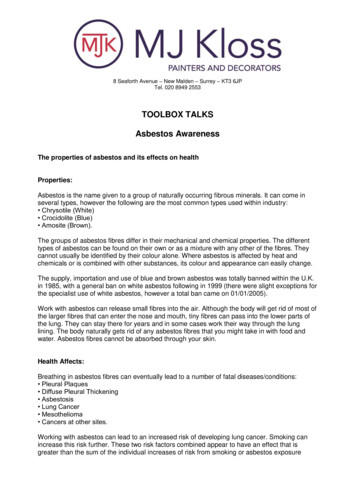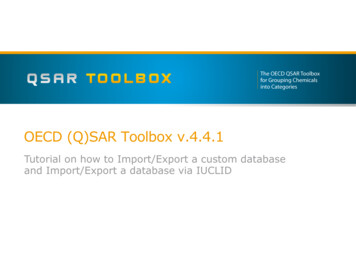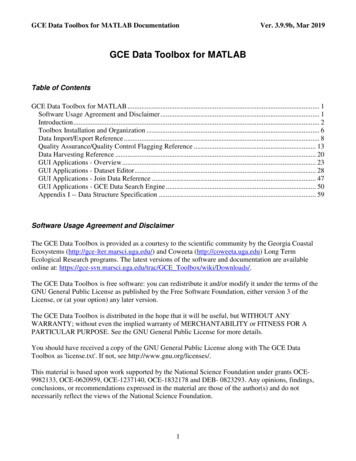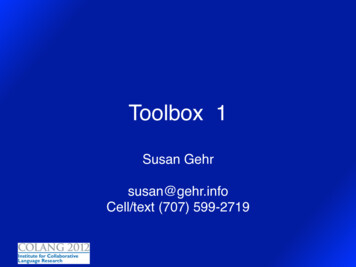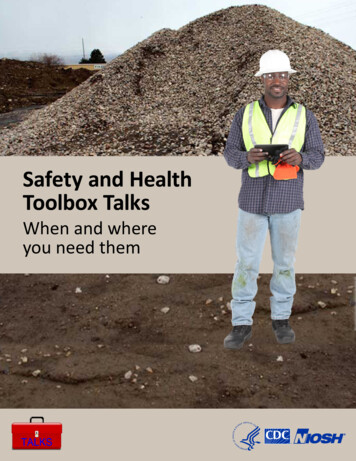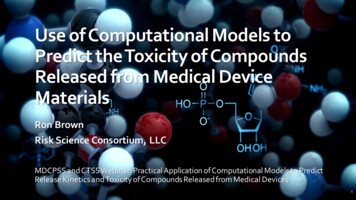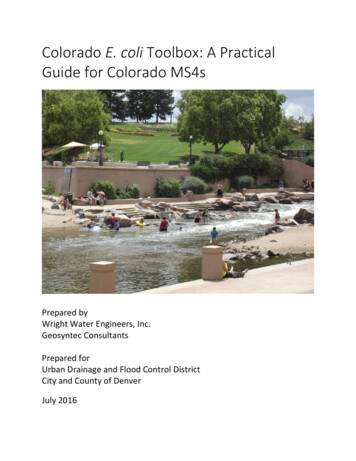
Transcription
MCKINNEY-VENTO IN ACTIONA McKinney-Vento Toolbox:Constructing a Robust and RigorousHomeless Education Program,In Case of Disaster and Every DayAUTHORSCarol Calfee, M.Ed.Director of Federal Programs and Local Homeless Education LiaisonSanta Rosa District Schools, FLPatricia Julianelle, J.D.Program Specialist, NCHEPro Bono Counsel, NAEHCYMarch 2007
This document was produced under U.S. Department of Education contract ED-04-CO-0056 0001. *U.S. Department of Education - Hurricane Help for Schools: Providing Assistance forSchools Serving Students Displaced by Hurricane mlFor more information on the McKinney-Vento Homeless Assistance Program, contactthe U.S. Department of Education, Student Achievement and School AccountabilityPrograms (SASA), Office of the Elementary and Secondary Education Act (ESEA).Phone: 202-260-0826Website: http://www.ed.gov/programs/homeless/index.htmlThe National Center for Homeless Education (NCHE) is a national resource center ofresearch and information enabling communities to address the needs of children andtheir families and of unaccompanied youth in homeless situations.NCHE is funded by the U.S. Department of Education and is housed at the SERVE Center at the University of North Carolina at Greensboro.Phone: 800-308-2145Website: http://www.serve.org/ncheVisit the NCHE website for information on In Their Own Words: School and StudentsRising Above. Based on interviews with school staff, relief agency staff, and students, InTheir Own Words provides a window into the daily challenges and triumphs of schoolsand students affected by Hurricane Katrina and shows the crucial role that schools andMcKinney-Vento programs play in the healing and recovery of individual families andentire communities following disasters.* The content of this publication does not necessarily reflect the views or policies ofthe U.S. Department of Education, nor does mention of trade names, commercialproducts, or organizations imply endorsement by the U.S. Government.
The Daily Challenges and Triumphs of StudentsAcknowledgementsThe tools contained in this document are based on fifteen years of practice in implementingthe McKinney-Vento Homeless Assistance Act and come from state departments of education, school districts, State Coordinators for Homeless Education, local homeless educationliaisons, community agencies, and national nonprofit organizations.The authors wish to express particular gratitude to the following key contributors:Tim Stahlke, Senior Program Officer of the Texas Homeless Education Office, for his vitalcontributions to this document from its inception to its final editing.Dianne Sepielli, Coordinator, Homeless Education Program, Broward County Public Schoolsin Florida, for her ideas, feedback, editing, and energy.Dr. Patricia Popp, State Coordinator for Virginia, for her sage comments and valuableresources.Christina Endres and Molly Chamberlin, Indiana Department of Education, for their constructive criticism and contributions to the draft report.Although it is impossible to recognize all the educators and organizations whose ideas,strategies, and tools appear within, the authors wish to highlight the following additionalcontributors:Rich DeHart, Illinois State Coordinator, retiredMelinda Dyer, Washington State CoordinatorBarbara James, Texas State CoordinatorJoanne Miro, Delaware State CoordinatorConnie Thompson, Houston ISD, TX; Homeless Education LiaisonSusan Underwood, former Arkansas State CoordinatorPatsy Williams, Lafayette Parish, LA; Homeless Education LiaisonSheldon Winnick, Pennsylvania State CoordinatorArizona Department of EducationCenter for Mental Health in Schools of UCLANational Association for the Education of Homeless Children and Youth (NAEHCY)National Association of School Psychologists (NASP)National Law Center on Homelessness & Poverty (NLCHP)National Volunteer Organizations Active in Disaster (NVOAD)Pennsylvania Department of EducationProject HOPE, VirginiaSubstance Abuse and Mental Health Services Administration (SAMHSA)Texas Homeless Education Office (THEO)MCKINNEY-VENTO IN ACTION
The Daily Challenges and Triumphs of StudentsIntroduction“If we have it right all the time, then we don’t have to worry aboutbeing unprepared for specific disaster situations.”Senior Program Coordinator, Texas Homeless Education Office*The nation’s public schools played a critical role in the response to the hurricanes of2005, and they continue to contribute to the recovery of individual families and entirecommunities. The McKinney-Vento Homeless Assistance Act and the staff chargedwith implementing it form the basis for this contribution.Following Hurricane Katrina, the Secretary of Education, Margaret Spellings, actedimmediately to contact impacted states to see what the U.S. Department of Educationcould do to support the enrollment of displaced students. The Department developeda Hurricane Help for Schools website (http://hurricanehelpforschools.gov/index.html)to provide quick responses to states asking for flexibility in operating school programs,as well as guidance and resources for states, districts, and schools, to identify helpingagencies, organizations, places for donations, and federal aid for displaced and homeless students. One of the first resources the website identified was information on theMcKinney-Vento Homeless Assistance Act.Children and youth who lost their housing due to the hurricanes were eligible forMcKinney-Vento services. This eligibility permitted their entry into schools and allowedschools to become a key to healing and recovery by enrolling displaced children withcompassion and efficiency, providing parents with information and assistance, andsupporting the mental, physical, and intellectual well-being of students and families ona daily basis.Students who lose their housing due to other disasters, such as floods, tornadoes,fires, and mudslides, are also eligible for McKinney-Vento services. Since such disasters can occur with no warning, school districts must be prepared to respond efficientlyto large numbers of homeless families and youth. Having a robust and rigorousMcKinney-Vento program is a key element to a successful disaster response. Responding to a disaster is easier if the school district has in place strong policies and practicesto enlist community support; to enroll and place students without documents; and tosupport basic needs, mental and physical health, and academic achievement. RigorousMcKinney-Vento programs allow school districts to serve all children and youth experiencing homelessness quickly and effectively.This toolbox is designed to help school districts implement the McKinney-Vento Actfully, so they can address the needs of children and youth experiencing homelessnesson a daily basis and in times of disaster.* Quotes throughout this document are from interviews in school districts highly impacted by the 2005 Gulf Coasthurricanes. The interviews are captured in the McKinney-Vento in Action: In Their Own Words. [Julianelle, (2006). McKinneyVento in Action: In Their Own Words-School and Students Rising Above. Washington, D.C.: U.S. Department of Education.]IIMCKINNEY-VENTO IN ACTION
The Daily Challenges and Triumphs of StudentsWhat Is In the Toolbox?This toolbox is meant to be exactly that: a package containing the basic tools necessaryto construct a rigorous and robust McKinney-Vento program. It contains tools to assistin: (1) developing strong community collaborations, including disaster planning andmitigation; (2) implementing the McKinney-Vento Act, including disaster response(consisting of identification, immediate enrollment, meeting immediate academic andhealth needs, transportation, nutrition, and data management); and (3) promotingmental health and academic success, including disaster recovery.The intent is not to focus on narrative or anecdotes, but to provide a collection ofuser-friendly tools: sample documents, templates, charts, checklists, etc. The toolboxalso contains extensive lists of useful web links. Each link is accompanied by a detaileddescription of the information it provides.Who Should Use The Toolbox?The toolbox should be used by school district local homeless education liaisons,district and school administrators, district federal program directors, and mentalhealth personnel at all levels. It contains useful tools and information for personnelwho are unfamiliar with the McKinney-Vento Act, as well as for the most experiencedlocal liaisons.The toolbox can also be used as a technical assistance and training tool by StateCoordinators for Homeless Education; state administrators; state federal programdirectors; and mental health personnel at all levels. Appendix 21 is designed to assistState Coordinators in using this toolbox.How Do We Use It?It is not necessary or even advisable to read the entire toolbox from beginning toend. To help users develop their own course of study, the toolbox begins with a briefself-assessment. The substantive contents of the toolbox are modeled on the self-assessment, following the same order and offering hands-on tools to improve the schooldistrict’s program in each area of the assessment. The self-assessment scores willinform users as to where they should begin in the toolbox. For example, areas wherethe assessment reveals a less-developed program are good places to begin work, whileareas where the user’s program is already functioning well may be lower priorities forimprovement.MCKINNEY-VENTO IN ACTIONIII
The Daily Challenges and Triumphs of StudentsSince the goal of the exercise is to produce a robust and rigorous McKinney-Ventoprogram, it is important for users to administer the self-assessment honestly andwith a critical eye toward their programs. Each chapter of the toolbox concludes with atargeted self-assessment to assist the user in evaluating the district’s implementationof the tools and strategies contained in that chapter.Of course, users interested in particular topics are welcome to go directly to the appropriate chapter, by consulting the table of contents or the topical index in Appendix 1.What If I Am Facing a Disaster Right Now?The goal of the toolbox is to encourage school districts to utilize its tools as fullyas possible prior to a disaster so that districts will be prepared and able to respondefficiently and effectively. However, for districts not entirely prepared for a disaster,Appendix 20 contains a Quick-Start Disaster Response Tool which provides a basicchecklist to guide immediate responses. This tool can also help new local homelesseducation liaisons prioritize their efforts and quickly implement the basics of a strongMcKinney-Vento program.THE MCKINNEY-VENTO HOMELESS ASSISTANCE ACT: guarantees the rights of children and youthexperiencing homelessness to a free andappropriate public education requires a local homeless education liaison inevery school district ensures: immediate enrollment access to needed services school stability support for academic achievementFor more on the McKinney-Vento Act, visitthe NCHE website O IN ACTION
The Daily Challenges and Triumphs of StudentsSELF-ASSESSMENTDoes your district have a robust and rigorousMcKinney-Vento program?School District Name:Individual(s) Conducting Assessment:Date of ate of Review:Rank the following in order of their effectiveness within your McKinney Vento Program:1No evidence2In existencebut not effective3Moderatelysuccessful4Successful butneeds improvement5Strength of theprogramI. Developing Strong Community Collaborations, Including Disaster Planningand MitigationA. Public, private, and community agencies are known to eachother, communicating and engaged in interdisciplinarydisaster planning.B. Public, private, and community services are coordinated,integrated, and delivered collaboratively.TOTAL SCORE FOR SECTION I(Community Collaborations) /10II. Implementation of the McKinney-Vento Act, Including Disaster ResponseA. Local liaison understands the rights of homeless children andyouth, and district policies are in line with theMcKinney-Vento Act to support the full, efficient and effectiveimplementation of federal law.B. Local liaison has a full understanding of the McKinney-VentoAct’s definition of homeless. Expedited identificationstrategies ensure that children and youth eligible for servicesare identified.C. Immediate enrollment strategies ensure that barriers toenrolling and remaining in school are eliminated.D. Strategies are implemented for placing students inappropriate classes without academic records and forobtaining complete school records.MCKINNEY-VENTO IN ACTION
The Daily Challenges and Triumphs of StudentsE. Aggressive and timely strategies ensure full, productiveparticipation in educational activities and include tactics toaddress physical and mental health needs.F. Strategies, policies, and procedures address anticipatedtransportation barriers.G. Strategies, policies, and procedures are in place to expediteplacement in school nutrition programs.H. Policies and procedures are in place to manage data trackingand reporting of student outcomes effectively.I. The district utilizes the media in a positive way.J. Strategies, policies, and procedures are in place to deal withthe coordination of donations.TOTAL SCORE FOR SECTION II(Implementation of McKinney-Vento) /50III. Mental Health and Academic Success, Including Disaster ResponseA. Strategies are in place to address the short- and long-termmental health and case management needs of studentsand families.B. Strategies, policies, and procedures are in place to deal withstaff fatigue.C. Strategies are in place to address the short- and long-termacademic needs of displaced students, including graduatingseniors.D. Funding: Needed services are available and accessible to all ina variety of settings using a combination of public, private,community, and personal resources.E. Strategies, policies, and procedures are in place to addresslong-term recovery issues, including housing needs.TOTAL SCORE FOR SECTION II(Mental Health and Academic Success) /25VIMCKINNEY-VENTO IN ACTION
The Daily Challenges and Triumphs of StudentsTable of ContentsI. Developing Strong Community Collaborations,Including Disaster Planning and Mitigation1A. Public, private, and community agencies are known to each other,communicating, and engaged in interdisciplinary disaster planning.131. Getting started: Identifying key players/stakeholders2. Getting a seat at the table: Joining community forums andinter-agency taskforces3. Setting a new table: Convening community forums andinter-agency taskforces4. Getting prepared: Designing a comprehensive disaster planTargeted Self-assessment:Evaluating the District’s Implementation of the Chapter’s Tools27B. Public, private, and community services are coordinated, integrated,and delivered collaboratively.281. Sharing information2. Developing memoranda of understanding3. Establishing robust communications systemsTargeted Self-assessment:Evaluating the District’s Implementation of the Chapter’s Tools7152129303133II. Implementation of the McKinney-Vento Act,Including Disaster Response34A. Local liaison understands the rights of homeless children and youth,and district policies are in line with the McKinney-Vento Act, to supportthe full, efficient, and effective implementation of federal law.3536381. Developing strong McKinney-Vento policies in school districts2. Developing additional policies specific to disaster situationsTargeted Self-assessment:Evaluating the District’s Implementation of the Chapter’s Tools40B. Local liaison has a full understanding of the McKinney-Vento Act’sdefinition of homeless and expedited identification strategies ensure thatchildren and youth eligible for services are identified.411. Understanding how to apply the McKinney-Vento Act’s definitionof homeless43MCKINNEY-VENTO IN ACTIONVII
The Daily Challenges and Triumphs of Students2. Increasing awareness of homelessness and the McKinney-Vento Actin schools and the broader communityTargeted Self-assessment:Evaluating the District’s Implementation of the Chapter’s ToolsC. Immediate enrollment strategies ensure that barriers to enrolling andremaining in school are eliminated.1. Forms for use during the enrollment process2. Talking to parents and youth: Timing of enrollment andschool selection3. Enrollment checklist4. Dealing with overcrowding when receiving a large number ofdisplaced students5. Other enrollment toolsTargeted Self-assessment:Evaluating the District’s Implementation of the Chapter’s ToolsD. Strategies are implemented for placing students in appropriate classeswithout academic records and for obtaining complete school records.1. Tools for obtaining academic records2. Placing students without records3. Enrolling students with special needs4. Strategies to help preserve records in cases of disastersTargeted Self-assessment:Evaluating the District’s Implementation of the Chapter’s ToolsE. Aggressive and timely strategies ensure full, productive participationin educational activities including tactics to address physical andmental health needs.1. Obtaining health records and addressing physical health needs2. Welcoming students and families into the school community andaddressing immediate mental health needs3. Preventing conflicts between new and previously attending studentsand serving all homeless children and youth4. Ensuring participation in athletics5. Contact list for students who have experienced a traumatic eventTargeted Self-assessment:Evaluating the District’s Implementation of the Chapter’s ToolsVIIIMCKINNEY-VENTO IN ACTION45484950515353545556575858606162636671737475
The Daily Challenges and Triumphs of StudentsF. Strategies, policies, and procedures address anticipated transportation barriers.Targeted Self-assessment:Evaluating the District’s Implementation of the Chapter’s ToolsG. Strategies, policies, and procedures are in place to expediteplacement in school nutrition programs.Targeted Self-assessment:Evaluating the District’s Implementation of the Chapter’s ToolsH. Policies and procedures are in place to manage data tracking andreporting of student outcomes.Targeted Self-assessment:Evaluating the District’s Implementation of the Chapter’s ToolsI. The District utilizes the media in a positive way.Targeted Self-assessment:Evaluating the District’s Implementation of the Chapter’s ToolsJ. Strategies, policies, and procedures are in place to deal with thecoordination of donations.Targeted Self-assessment:Evaluating the District’s Implementation of the Chapter’s Tools76787981828485888992III. Mental Health and Academic Success, IncludingDisaster Recovery93A. Strategies are in place to address the short- and long-term mental healthand case management needs of students and families.931. Assessing needs2. Planning to meet mental health needs3. Potential supplemental funding for mental health needs4. Hands-on resources for mental94949596Targeted Self-assessment:Evaluating the District’s Implementation of the Chapter’s Tools99B. Strategies, policies, and procedures are in place to deal with staff fatigue.Targeted Self-assessment:Evaluating the District’s Implementation of the Chapter’s ToolsMCKINNEY-VENTO IN ACTION100104IX
The Daily Challenges and Triumphs of StudentsC. Strategies are in place to address the short- and long-term academicneeds of displaced students, including graduating seniors.1. Collaborating with Title I2. Ensuring that seniors can graduate3. Supporting highly mobile students4. Supporting young children5. Supporting students with special needsTargeted Self-assessment:Evaluating The District’s Implementation Of The Chapter’s Tools.D. Funding: Needed services are available and accessible to all in a variety ofsettings—using a combination of public, private, community, and personal resources1. Grants available from the U.S. Department of Education2. Grants from other federal sources3. Funding available from community and private sourcesTargeted Self-assessmentEvaluating the District’s Implementation of the Chapter’s ToolsE. Strategies, policies, and procedures are in place to address themultiple issues of long-term recovery, including housing needs1. General resources for families2. Forming a long-term recovery committeeTargeted Self-assessmentEvaluating the District’s Implementation of the Chapter’s Tools MCKINNEY-VENTO IN 9121
The Daily Challenges and Triumphs of StudentsAppendicesAppendix 1: Topical Index124Appendix 2: Comprehensive Community Stakeholders Chart128Appendix 3: Glossary of Key Terms and Acronyms in Disaster Planning,Response, and Recovery139Appendix 4: Sample Letter to a Collaborative Taskforce Invitee149Appendix 5: Determining Eligibility for Rights and Services under theMcKinney-Vento Act150Appendix 6: Sample Enrollment Forms157Appendix 7: Questions for Discussing Enrollment Timing with DisplacedParents and Youth164Appendix 8: School Selection: A Checklist for Decision Making165Appendix 9: Enrollment Checklist166Appendix 10: Prompt and Proper Placement: Enrolling Students Without Records 167Appendix 11: Records Management Checklist173Appendix 12: Delaware Interscholastic Athletic Association Policies forHomeless Students174Appendix 13: Contact List for Students Who Have Experienced a Traumatic Event176Appendix 14: Sample Transportation Forms177Appendix 15: Sample Free Meal Application Form179Appendix 16: Media Relations Tip Sheet183Appendix 17: Disaster Assessment and Referral Tool for Children and Adolescents 185Appendix 18: Disaster Mental Health Plan Checklist187Appendix 19: Sample Case Management Form189Appendix 20: Quick-Start Disaster Response Tool191Appendix 21: State Coordinators’ Companion193MCKINNEY-VENTO IN ACTIONXI
Community CollaborationsMcKinney-Vento ToolboxThe toolbox follows the same order as the self-assessment. The tools focus oneach point in the self-assessment and are designed to enhance the district’scapabilities in that area.I. Developing Strong Community Collaborations,Including Disaster Planning and MitigationA. Public, private, and community agencies are known to eachother, communicating, and engaged in interdisciplinary disasterplanning.“School districts need to be involved in the community, so thereare strong connections already in place before a disaster, so thecommunity is working together, ready and willing to help. Thetime of a crisis is not a good time to be asking for business cards.You need to have those relationships in place.”Local Homeless Education LiaisonSchool districts cannot meet the needs of families and youth experiencinghomelessness alone. Homelessness is a community-wide problem, requiring acommunity-wide response that includes measures to address housing, health care,and employment, along with school attendance and success. Therefore, effectiveimplementation of the McKinney-Vento Act requires a community-based approach tohomelessness and education. Without the support of local agencies, local homelesseducation liaisons cannot identify and serve all the children and youth experiencinghomelessness in the district.Although initiating community collaborations demands an investment of timeand energy, the returns on that investment can be remarkable. Collaborating withcommunity organizations and agencies will make the school district McKinney-Ventoprogram stronger and more successful.MCKINNEY-VENTO IN ACTION
Community CollaborationsWhat can community agencies offer the schooldistrict’s McKinney-Vento program?School SuppliesDental CareSpace For After-school ActivitiesFunding Translation Of Awareness MaterialsClothing And Shoes Field TripsHelp Finding And Identifying Homeless Children And YouthMedical Care School UniformsSocial Work And Counseling AssistanceMental Health Care BooksPayment Of School FeesEmployment For ParentsTutoring And MentoringFoodTransportation For Students And ParentsEyeglassesHousing For Homeless Families And Youth MCKINNEY-VENTO IN ACTION
Community CollaborationsSimilarly, community disaster planning also requires a collaborative and coordinatedeffort by public, private, and community agencies. Schools must be a part of that effort.Schools and relief agencies agree that the biggest barrier to getting displaced studentsinto school and keeping them there, is a lack of communication between the agenciesand the schools. Communicating early and often will help ease everyone’s burden.Through patience and persistence, local liaisons have established strong relationshipswith disaster relief agencies, thereby securing hundreds of thousands of dollars ingrants and creating permanent housing programs to serve homeless children andfamilies.This section contains tools to assist in implementing strong, creative collaborations,including:1. Getting started: Identifying key players/stakeholders2. Getting a seat at the table: Joining community forums and inter-agency taskforces3. Setting a new table: Convening community forums and inter-agency taskforces4. Getting prepared: Designing a comprehensive disaster plan1. Getting Started: Identifying key players/stakeholdersThe first step in building strong collaborations is identifying community members thatcan support the McKinney-Vento program’s needs. Every community has agencies,organizations, and individuals with a stake in supporting the education of homelesschildren and youth and being prepared for disasters. In fact, every member of thecommunity is a stakeholder. Experienced local liaisons emphasize that it is importantto “think outside the box” when considering potential collaborative partners.“I was in the Walgreens here in town, getting a prescription for ayoung man I was serving a few days after Katrina hit. The line waslong, and I started talking with someone from Baton Rouge, wetalked about our work and what we were doing, and he told me hewas going to put someone in touch with me to help with my work.I had an e-mail waiting for me when I got back to the office, whichput me in touch with ADRA, [Adventist Development and ReliefAgency, an NGO relief program from the Czech Republic] and gotme funding from the Czech Republic. 90,000. I have used thatdonation to place different counseling personnel at different sites.”Local Homeless Education LiaisonMCKINNEY-VENTO IN ACTION
Community CollaborationsLocal liaisons who are new to community collaborations may have trouble knowingwhere to start. It may help to assess the program’s needs, determine those that aremost pressing, and identify community members that may be able to help meet thoseneeds. Alternatively, the local liaison may wish to begin with those organizationswith which he/she feels most comfortable, gradually expanding those collaborativerelationships to other community members.The following chart is a first step in starting collaborations. Local liaisons may wish tobegin with the listed organizations and gradually add more groups and individuals astheir collaborative relationships grow. For additional groups, consult Appendix 2, whichcontains a chart suggesting a large variety of stakeholders that can be important insupporting the McKinney-Vento program and planning for disasters.Tip: One experienced local liaison advises:“Never let anyone get away without talkingto them about homeless kids.” Such conversations can lead to important partnershipswith everyday contacts: doctors, neighbors, coworkers, accountants, fishing buddies,Little League coaches, real estate agents, hairdressers, fellow chorus members, mechanics, friends from church, insurance agents, poker buddies, friends from book group, etc. MCKINNEY-VENTO IN ACTION
MCKINNEY-VENTO IN ACTIONMcKinney-Vento Homeless Assistance Act programs administered by the U.S. Dept.of Housing and Urban Development (HUD) require communities to develop a CoCsystem. The CoC is designed to coordinate a community-based process of identifyingand addressing needs. Members include all agencies and organizations providingservices to homeless people in the community. To find local contact s/programs/cont/coc/HUD CONTINUUM OF CARE (COC)Check the phone book or Internet site of your town for local contact information.SHELTERS FOR FAMILIES, YOUTH, AND SURVIVORS OF DOMESTIC VIOLENCETo find local or state es/state/index.htmlHOMELESS COALITIONSIn many communities, these organizations provide the bulk of social services,includingshelter, food, mental and physical health support, legal assistance, and other services.FAITH-BASED COMMUNITIES AND CONGREGATIONSAmerican Legion (http://www.legion.org/?content post locator)Boys’ and Girls’ ClubsBoys Scouts/ Girls Scouts of AmericaGoodwill (http://www.goodwill.org/page/guest/about)Junior League (http://www.ajli.org)Kiwanis International (http://www.kiwanis.org/clubloc)Knights of Columbus .cfm)Lions Club (http://www.lionsclub.org/EN/content/resources club.shtml)Rotary International men’s ClubsYMCA/YWCA (http://www.ymca.net or http://www.ywca.org)CIVIC ORGANIZATIONSOrganizationLocal Contact InformationContacted? Follow-upCHART 1: Key CollaborativePartnersChart 1: Key CollaborativePartners
MCKINNEY-VENTO IN ACTIONhttp://www.nvoad.org(Provides a venue for agencies to coordinate, collaborate, communicate, andcooperate on disaster planning, training and response.)VOLUNTARY ORGANIZATIONS ACTIVE IN DISASTER (VOAD)Contact your school district for local ed.gov/about/offices/list/osdfs/programs.htmlSAFE AND DRUG-FREE SCHOOLS DISTRICT COUNCIL COMMITTEETo
This toolbox is designed to help school districts implement the McKinney-Vento Act fully, so they can address the needs of children and youth experiencin
